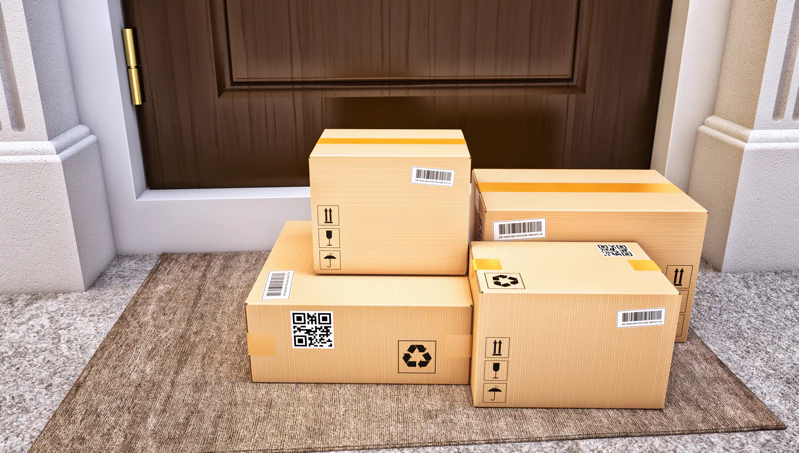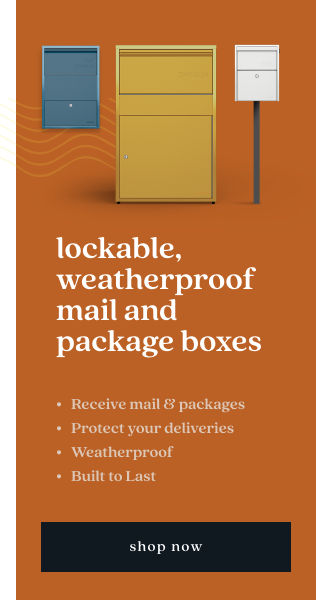Blog Topics
Last FootThe Last Foot of the Supply Chain is Presenting New Challenges

By Dr. Ben Stickle, Ph.D.
Associate Professor at Middle Tennessee State University
The front porch is making a comeback! It is increasingly becoming the central hub for commerce—causing dramatic shifts from traditional in-store purchasing to convenient package deliveries to the home. According to the U.S. Department of Commerce, as of 2020, online sales account for roughly 14 percent of the total sales volume in the United States, which is up from 11.3 percent in 2019.1
In 2021, online retail sales in the U.S. are expected to amount to approximately 5 trillion dollars, doubling in value since 2017.2 This trend in online growth is generally expected to continue, and as more consumers purchase an ever-increasing variety of goods and have them delivered to their homes, ensuring that they receive their products on time and undamaged is vital to the reputation of suppliers, retailers, and shipping companies. In other words, as society relies on E-commerce to make purchases, the last segment of the supply chain becomes ever more important.
The last part of the supply chain is colloquially known as “The Last Mile” of delivery logistics and refers to the process of moving purchased products from a warehouse or fulfillment center to their destination at a customer’s home or business. In the United States and many other countries, mainstream business practices currently operate with the assumption that the retail supply chain ends when the products are delivered to the customer’s doorstep. This is an outdated perception that does not fit the diverse needs of the consumer. Now that consumers can have virtually any type of product delivered to their homes, including medications, groceries, electronics, jewelry, collectibles, and a host of other goods, this creates special consideration for the security and care for the items that current business practices do not address.
Because most packages are left unattended at the consumer’s doorstep, the items are vulnerable to product loss, product damage, and theft. For example, when considering package theft alone, one recent survey estimated that over 35 million Americans were the victims of the crime in 2020, resulting in approximately 5.4 billion dollars in financial losses.3 Incidents where packages are misplaced, damaged, or stolen cause frustration on the part of the consumer, which may make the consumer wary of making subsequent online purchases. Moreover, these issues cause substantial financial hardships for retailers and shipping companies since they will incur additional costs in replacing the item or refunding the purchase (think manufacturing costs, labor costs, transportation costs, and delivery costs).

The bottom line is that for businesses to maintain a competitive advantage in E-commerce markets, industry professionals need to concentrate on the time that packages are placed on the porch to the time the customer receives them. In other words, the industry needs to focus not merely on “The Last Mile” of the package delivery process but “The Last Foot,” so to speak. Packages should not be considered wholly delivered until they are successfully received in good condition by the intended recipient. The Last Foot of the supply chain is a critical area of focus because the business obligation and the obligation to the consumer extends past the porch; leaving packages unattended on doorsteps is no longer an adequate strategy.
The Last Foot
When talking about “The Last Foot,” there are four critical aspects that need to be addressed:
- Physical space (often the porch or area of the property where packages are left unattended)
- Time (the time between unattended delivery and customer receipt of the packages)
- Care of the item (whether the goods need to be insulated, heated, refrigerated, have enhanced security measures in place, or protection from adverse weather)
- The customer experience (including satisfaction & convenience with the delivery process)
Risks & Losses in the Last Foot
Risks in the last foot are numerous, and while this section of the supply chain may be the shortest, both in time and space, it is fraught with the most risks, highest losses, and significant impact to many stakeholders. While the product’s journey is relatively short (in time and distance compared to the entirety of the supply chain), the Last Mile, and by extension, the Last Foot is the most expensive part, accounting for nearly 40% of operating costs.
Consumers can experience a loss during The Last Foot of delivery in the following ways:
- Damage due to Weather (Heat, Wind, Water, Cold)
- Loss due to Theft4 (Porch Piracy)
- Reduction in Privacy (Neighbors see the volume of packages and brand names)
When a loss occurs, the ripple effect is felt across the supply chain. The areas most impacted by a loss at the last foot are consumers, delivery companies, and retailers.
Customer Experience in the Last Foot
As the shopping experience has turned virtual, the only physical link to a brand is product delivery for many people. Significant research has been gathered describing how a poor online shopping experience impacts brand image, trust, and future purchases, which holds implications for both a marketing and logistics standpoint.5 Retailers know the consumer experience must be hassle-free and quick, or shoppers will go to other websites. While understudied, early research indicates consumers may have similar attitudes if products are lost, stolen, or delivered damaged. Further, consumers are unlikely to distinguish between a problem with the retailer’s website host or the payment processor—they just know there was a problem and tend to blame the retail store, which may impact the future buying decision.6
Similarly, issues at the last foot are rarely seen as delivery company responsibility; blame and poor brand trust are assigned to the retailer. This is why the last foot is critical for retailers to consider. As the direct contact with the consumer shrinks, the experience at the last foot needs to be positive. However, customer experience does not end with the receipt of a product by a customer. Many retailers offer and promote a hassle-free, no-cost return program. The most convenient approach for consumers to return items involves allowing the supply chain to operate in reverse. Consumers place the item to be returned outside their home for pick-up by a delivery company. Because items are left in the open, this approach doubles the risks of product loss, damage, and theft.
Industry Impacts in the Last Foot
Retailers, suppliers, delivery services, and consumers are all impacted by losses and risks in the last foot. However, securing the last foot and ensuring delivery will reduce losses for current stakeholders and allow a new class of deliveries, thus opening the door for service expansion. A secure last foot—secure from theft, tampering, weather, and more—will allow new industries to deliver directly and to consumers. These services include food deliveries from restaurants and grocers, medication deliveries from pharmacies, flowers, alcohol; and electronic deliveries from specialty retailers, and more. Solving the last foot problems opens the door to a more significant number of services and increased consumer satisfaction.
Efforts to Address the Last Foot
While the concept of the Last Foot may be new, efforts to protect packages at this stage in the supply chain are not. Loss mitigation techniques, specifically targeting theft, such as cameras, signs, Post Office Boxes, Parcel Delivery Lockers, delivery to alternatives addresses, such as neighbors or work locations, and even disguising packages, are all being implemented with varying success. However, three critical aspects of theft prevention should be considered when examining the impact prevention products or methods; deterrence, security, and concealability. Deterrence is anything that discourages theft. Securing a package refers to physical efforts that prevent a package from being removed. Finally, concealing a package removes the opportunity for a thief to target the item.
Many products and methods used today fail to meet all three of these. For example, cameras, at best, may have a deterrence effect but do not conceal or secure. Hiding a package behind a planter may conceal the item but does not secure it. The best method to reduce thefts incorporates all three aspects; deterrence, concealability, and security. While some methods, such as parcel lockers or PO Boxes, satisfy these requirements, they are inconvenient for the consumer and unlikely to be adopted widely in the United States. The only product that meets the three criteria for maximum protection and is convenient for consumers is a lockable delivery container installed at a residence. These items provide the best level of protection for all circumstances and address many of the other potential losses in the last foot. Currently, Adoorn7 is the leader in this market.
Conclusion
The Last Foot of the supply chain is often neglected in the Last Mile of the delivery process by retailers, shippers, delivery services, and even consumers; yet it is the most critical risk of loss and customer satisfaction. Most retailers and delivery companies currently leave a package or good on a porch and consider the last mile to be complete. In reality, until the customer retrieves their package undamaged and safely within their home, the last mile is, arguably, incomplete. Much can happen between an unattended delivery and the receipt of a package, yet little attention has been given to this topic. This paper has established the “Last Foot” of the supply chain to account for this lack of focus and concern. Developing this concept will help retailers, researchers, suppliers, delivery companies, and industry leaders focus on unattended deliveries, including the risks involved and customer satisfaction, while opening new avenues of home delivery and reducing costs.
The last foot is the first step towards enhancing E-commerce business potential and the consumer experience.
1 U.S. Census Bureau News: Quarterly Retail E-Commerce Sales
2 Retail E-Commerce Sales Worldwide from 2014-2024
4 Porch Pirates: Examining Unattended Package Theft through Crime Script Analysis
5 Online Retail Experience and Customer Satisfaction: The Mediating Role of the Last Mile Delivery
6 Accessing the Fear of Package Theft
7 Adoorn
Adoorn has been at the forefront of solving problems that occur once packages are delivered but have yet to be received--such as package theft, weather damage, and grocery spoilage. We are calling these collective issues "The Last Foot" of the supply chain.
We asked Dr. Ben Stickle, a leading authority in package theft, to help lay out exactly what the Last Foot is, the problems it presents, and how these issues might be solved. Here is the paper Dr. Stickle's published to this end.
About the Author
Dr. Ben Stickle
Ben Stickle is an Associate Professor of Criminal Justice at Middle Tennessee State University. He is a recognized expert and industry forerunner addressing loss in the last mile delivery, focusing on package theft.
His work includes scholarly articles on COVID-19's impact on crime, package theft, and practitioner-focused articles in The Mail & Express Review, Loss Prevention Magazine, and The Business Insider. Ben's research has appeared in nearly 100 news reports, websites, and blogs, including Parcel & Post Technology, U.S. News & World Report, The Postal Hub, Good Morning America, New York Times, BNC Investigative Reporting, and others. Ben has presented on package theft to the Loss Prevention Research Council, Post & Parcel Live, Clear Link Consumer Brands, ASIS International, Criminology Consortium, and others.
For more information visit: www.benstickle.com/package-theft

